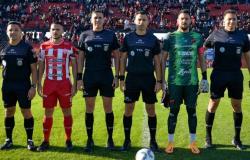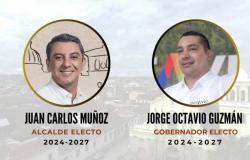
When talking about the galleon San José, sunk in the sea Caribbean of Colombia 316 years ago, many fantasies emerge, for example: that it will serve to pay Colombia’s external debt or that it will allow the construction of two lines of the postponed Bogotá metro. It is as if that galleon embodied the eternal dream of Colombians of winning a lottery that would make so many other postponed dreams possible.
But the current government’s project regarding the San José galleon is totally opposite to that of those who see the wreck – a word that designates a piece, portion or fragment of a shipwrecked ship – as a treasure. Hence the minister of Cultures, the arts and the Knowledge of Colombia, Juan David Correa, ensure that “Colombia does not consider the San José galleon as a treasure; “It is an archaeological wreck, a submerged heritage.”
The galleon was sunk in the Caribbean, near Barú Island and off Cartagena, by British privateers in 1708, when it came from Porto Belo, Panama; It carried a cargo with tons of coins, jewelry and gold bars, and everyday objects, without forgetting that it carried 600 people who perished in shipwreck.
Read also: Colombia expels Argentine diplomats for Milei’s insults to Petro
The debate surrounding the San José – with questions such as who is the final owner and how much he has – was activated after the remains of the vessel were discovered in November 2015 by researchers from the Colombian Institute of Anthropology and History (ICANH) and the Colombian National Navy.
But it was last February when the “Management Plan for the Protected Archaeological Area of the Asset of Cultural Interest – BIC Galeón San José” was launched, which is the project of the current government, which is part of an alliance between the Ministry of Cultures, and ICAHN and the Navy, without the participation of private companies, and without promises to divide the cargo between States or individuals.
Colombia is talking about investigating and studying the wreck; He does not talk about going with a dredge and removing it like a machine is removed from the bottom of the sea. “Colombia does not share the idea of rescuing a treasure, removing it and, supposedly, distributing it under the argument that the pieces, as they are repeated, did not mean greater heritage, but rather a possibility of economic wealth,” the minister says in a telephone interview. Juan David Correa.
Journalist, editor and writer, Correa has been minister since August 2023, and upon his arrival, President Gustavo Petro asked him to take up the galleon issue; He says that he found that both the ICAHN and the Navy had made progress in recent years in research, so they proposed the project to the president:
“Rear Admiral (Hermann) León explained to him: ‘President, we have been preparing for eight years to be the ones who can carry out the first investigation on the archaeological wreck, we have the ship – we bought it in China a few years ago -, we have a robot that is going to help us.’ allow us to carry out at least the first phase of the exploration, we have the possibility of providing a laboratory at the Navy headquarters, in Cartagena, with sufficient tools to establish the investigation, and we also have work with communities surrounding the site of the shipwreck. ‘. All of this means – the minister highlights – changing the idea that someone from outside has to come or that it has to be a public-private alliance with a technology company from another country because we are not capable.”
Read also: Colombia and Ecuador hope to agree with Mexico on operating rules so that dollars can be allocated for migrants
From this, a budget of just over four million dollars was allocated for 2024, contributed in equal amounts by the Ministries of Culture and Defense, in order to carry out three specific actions this year.
The first action of this Plan was developed a month and a half ago, in Cartagena, and was the symposium “Perspectives and Challenges of the Research Project at the BIC Galeón San José”, where Colombia presented its proposal that Correa summarizes as follows: “For us “It is not an extraction process in a traditional sense, it is a research possibility.”
The symposium brought together specialists from Colombia and other countries, as well as special guests, among whom were representatives of the Qhara Qhara nation of Bolivia, which claims ownership of the gold and silver cargo of the galleon that came from, among others. places, from the Potosí mines; Another guest was Spain, which proclaimed itself owner of the galleon because it was “a ship of state.”
Finally, critical voices from Colombia also participated in the meeting and have questioned the project, and who assure that it is an improvised plan; The authorities deny this and argue that the final management plan will be drawn up based on the results of the investigation.
A few days after the symposium, an international group of specialists – among whom is the Mexican archaeologist Roberto Junco, head of the subdirectorate of Underwater Archeology of the INAH – sent a letter where they recognized that the Colombian State project “stands as one of the most innovative intersectoral, interinstitutional and interdisciplinary initiatives undertaken to date in the world for the preservation, research, enhancement and dissemination of submerged cultural heritage.
Read also: Colombia explores measures after Milei called Petro a “terrorist murderer”
However, in parallel the Colombian State faces two lawsuits with foreign companies; One is with the American company Sea Search Armada, which claims half of the cargo or ten billion dollars, arguing that it was the first to find the galleon, more than 40 years ago. However, the galleon is an Asset of Cultural Interest, and as such was declared in 2020; This is one of Colombia’s several arguments in the litigation.
Precisely, and as another of the actions that will be carried out in 2024, is the declaration of the protected archaeological area – as a guarantee for its preservation.
But it will be in April or May, when the first direct action will take place at the site of the wreck. A robot will reach it, 600 meters deep, in an area where human life cannot go. Minister Correa explains: “We will do a very simple and small extraction, just to check what the result is of extracting two, three or four material things from the bottom of the sea, and what their behavior is when they come into contact with oxygen. It won’t be much, we can’t extract large amounts of materiality; it will be wood, ceramics, pieces from the surface of the marine niche; We are not going to excavate anything at all. For this we are going to invite representatives of the Qhara Qhara nation and the Spanish government to the ship.”
The minister adds that the third action in 2024 is to propose a method and infrastructure for research into submerged heritage: “If we can leave the new generations with a ship—in the Colombian Caribbean we have 20 or 25 shipwrecks—a laboratory and the concurrence of several ministries, we will be able to work on a specific mission. This year will be the first phase; We will publish the second phase and communicate once we have the results of this first. Serious science does not make decisions before observing, examining and looking.”
Read also: In the middle of the electoral ban, Taibo II praises programs of the Economic Culture Fund in Mexico City
You talk about a project that seeks to degaleonize the galleon, what does it mean?
We want to tell the world: “let’s degaleonize the discussion, let’s take away the price and, rather, put the emphasis on its historical, investigative, scientific and cultural value”; This is an opportunity to work together and talk about colonialism. If we took that out today, what we would have would be a confrontation between various positions. The San José, for 40 years, has been seen as a pirate treasure: that it belongs to some or that it belongs to others, and for which we have to confront. We believe that it is an archaeological wreck and that we can investigate and put it at the service of science and culture in the world, as an example of a society that invests in a research idea and in the possibility of building a path for archaeologists to be trained in Colombia. submarines, so that there is a laboratory, so that other countries come to learn from us and so that throughout the continental Caribbean of Latin America we can do research. And there is an opportunity to create a museum, at some point, probably not with the physical pieces, but a digital museum.
Remains of the ship and its rich cargo, which included cannons, tons of coins, jewelry, gold ingots and everyday objects such as bottles and porcelain tableware, which were left at the bottom of the sea since 1708, when British privateers attacked it. Photos: Ministry of Cultures, Arts and Knowledge of Colombia/ Mauricio Builes, mincultura
. What were the responses of Spain and the Qhara Qhara nation of Bolivia?
What the Qhara Qhara are telling us, and I met with them in Cartagena, is that if tomorrow we make the decision to go with a dredge and remove it without investigating, then they are going to demand their gold and silver, and that Spain will be left with its wood and the slabs it brought; But what they mean is that if we are going to take care of this, as we are taking care of it, they will accompany us to take care of it. The invitation, of course to Spain, is to also help us take care of it; The Spanish ambassador was there, he listened to the Qhara Qhara and they listened to him. That is a powerful symbol of encounter and conversation, without agreeing on everything; everyone has reservations
Colonialism is, without a doubt, in the discussion…
Today the conversation is happening in Europe; India, Egypt, many countries are demanding that the colonies return their things; ourselves; The president of Mexico made a strong response to the Spanish Government… but we always settled into rage. What we want to produce are conversations about these difficult topics; Why are we afraid to speak horizontally between Spaniards and Colombians, between Spaniards and Cubans, between Spaniards and Mexicans, between Mexicans and Austrians, or between Bogota and Amazonians? Art and culture teach you, through an artifact or representation, to think about things you might not otherwise think about.
Join our channel
EL UNIVERSAL is now on Whatsapp! From your mobile device, find out the most relevant news of the day, opinion articles, entertainment, trends and more.





